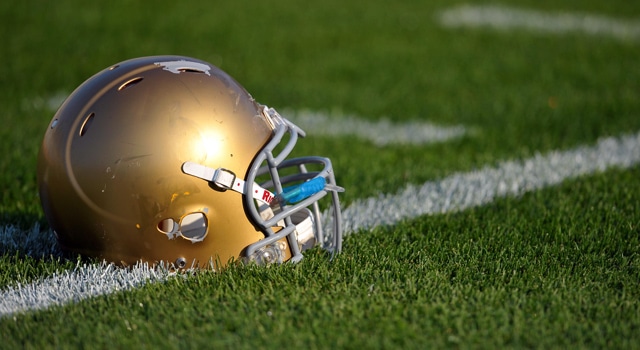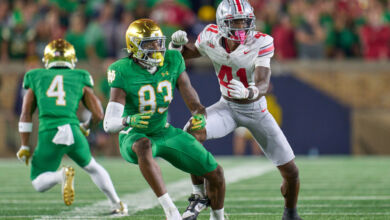
National Signing Day 2013 was a massive success for the University of Notre Dame. It went so well that the faxes churning out one-by-one throughout the day seemed more like a wish list of players than Notre Dame’s actual signing class. And when Rivals 5-star defensive lineman Eddie Vanderdoes announced his decision to attend Notre Dame over USC, Alabama and UCLA, you could easily envision every Notre Dame fan in the country jumping out of their seat and shaking hands, like a NASA control room that had just successfully landed a rover on Mars after a year’s worth of planning. The Fighting Irish signed four 5-star players in the class of 2013, the very first time that has been accomplished since Internet recruiting was established.
But does it matter? That question is debated every year amongst every fan base on every football message board in the country. Recruiting rankings are subjective, and not every recruit pans out. Just as not every 1st round selection in the NFL Draft goes according to plan (bonus points if you recognize the name Tony Mandarich). Whenever one individual points out the success of teams like Alabama and connects it to their recruiting muscle, another individual will single out Boise State and ask how they can continuously challenge without top recruiting classes. Attempts have been made to settle these debates by looking at evidence, but the problem is the methodology has always been flawed.
When the connection between recruiting and results is traced, many erroneously take a recruiting class and use the following year for their argument. For example, it would be akin to taking Notre Dame’s recruiting Class of 2013 and then examining Notre Dame’s on the field success the following season. Such a process is illogical considering those recruits will be freshmen, and while freshmen can contribute and succeed, generally a recruiting class doesn’t begin to place its mark on a program until they become upperclassmen. Some sites have even begun comparing back-to-back recruiting classes to get a more in-depth feel of success, and, while more effective, it still misses the mark. A more accurate way to examine to what extent recruiting and football results are connected is to take a particular recruiting class and measure a program’s football results three years down the line.
This article will examine the top five recruiting classes on Rivals starting in 2002 and compare those rankings to the programs who finished the season in the AP top five three seasons later. The intent is to see if a top five finish in recruiting translates to a top five finish in the AP poll. An “R” by a year indicates the recruiting rankings, and an “F” by a year indicates the on-field football results.
Table 1 (Recruiting: 2002-2005, Football: 2005-2008)
|
2002-R |
2005-F |
2003-R |
2006-F |
2004-R |
2007-F |
2005-R |
2008-F |
|
Texas |
Texas |
LSU |
Florida |
USC |
LSU |
USC |
Florida |
|
Tennessee |
USC |
Florida |
Ohio State |
LSU |
Georgia |
Florida St. |
Utah |
|
Georgia |
Penn State |
USC |
LSU |
Florida St. |
USC |
Oklahoma |
USC |
|
Florida St. |
Ohio State |
Oklahoma |
USC |
Miami |
Missouri |
Tennessee |
Texas |
|
Ohio State |
WVU |
Miami |
Boise St. |
Michigan |
Ohio State |
Nebraska |
Oklahoma |
Table 1 offers some interesting insights. There is definitely a correlation between a top five recruiting class and a top five AP finish three years later. Every season examined led to at least 40% of those with a top five recruiting class finishing in the top five of the AP, meaning each team, with a top five recruiting class, had an 8% chance of being in the top five of the AP poll three years later. Another interesting find: of the four years examined, all four years had one of the top five recruiting classes playing for a national title (2005: Texas, 2006: Florida, 2007: LSU, 2008: Oklahoma). Amazingly, this means that of the classes examined, if you finished with a top five recruiting class, you had a 20% chance of playing (win or lose) in the national championship game three years later.
Table 2 (Recruiting: 2006-2009, Football: 2009-2012)
|
2006-R |
2009-F |
2007-R |
2010-F |
2008-R |
2011-F |
2009-R |
2012-F |
|
USC |
Alabama |
Florida |
Auburn |
Alabama |
Alabama |
Alabama |
Alabama |
|
Florida |
Texas |
USC |
TCU |
ND |
LSU |
LSU |
Oregon |
|
Florida St. |
Florida |
Tennessee |
Oregon |
Florida |
Okla. St. |
Ohio State |
Ohio State |
|
Georgia |
Boise St. |
LSU |
Stanford |
Ohio State |
Oregon |
USC |
ND |
|
Texas |
Ohio State |
Texas |
Ohio State |
Miami |
Arkansas |
Texas |
Georgia |
Table 2 also tells an intriguing story. In the 2007 recruiting class/2010 football results, there were no matches between the top five recruiting classes and the final top five in the AP poll. Interestingly enough, the University of Florida won the recruiting title in 2007 but Auburn won the national championship in 2010. They share one common element: Cam Newton. Newton, a 5-star QB that signed with Urban Meyer’s Florida Gator squad in 2007, eventually transferred to Auburn where he won a national title in 2010.
The following recruiting year of 2008/football season of 2011 had another interesting result. Only one of the five top recruiting classes finished in the top five of the final AP Poll (Alabama). Every other program that made up the top four recruiting classes for 2008 eventually went through a head coaching change before the 2011 season (Notre Dame: Charlie Weis, Florida: Urban Meyer, Ohio State: Jim Tressel, Miami: Randy Shannon), a perfect illustration of other variables that influence program success.
Overall, there were 14 matches out of 40 possibilities, meaning that in any given year 35% of the teams who finish in the top five in recruiting make it to the top five of the AP poll three years later. So, in any given season, each team that finishes with a top five recruiting class has a 7% chance of finding themselves in the top five of the AP poll three years later. In addition, at least one of the top five recruiting classes played in the national title game 7 out of 8 years, meaning 87.5% of the time one of the top five recruiting classes played in the title game three years later. In any given recruiting season, a program with a top five recruiting class has a 17.5% chance of appearing in the national championship three years later.
Do recruiting rankings matter? With the signing of Notre Dame’s Class of 2013 the Fighting Irish now possess a 7% chance of finishing in the top five of the AP poll in 2016, and a 17.5% chance of playing for the national championship the same year.
Yes, recruiting rankings matter.




I should have made my explanation clearer. If there’s a 35% chance that the top five recruiting classes will also appear in the top five of the AP poll three years later, that would mean each of the teams in the top 5 in recruiting has a 7% amongst themselves to be among that 35% (only looking at those five teams).
That should have been explained better on my part. Same goes for the championship percentage. 87.5% of the time a team from a top 5 recruiting class played in the title game three years later. That would mean each team (only among the top five recruiting classes) has a 17.5% chance of playing in the title game three years later.
I like the analysis but don’t understand one conclusion. How do you have a 17% chance of playing in the NC game but only a 7% chance of being in the top 5 in the same year?
Love the analysis, and the thoughtful commentary. However, the probability conclusions are flawed. You can’t have an 8% chance of being in the top 5 and yet a 20% chance of playing in the NC game (1st grid), and a 17.5% chance of playing in the NC game but only a 7% chance of finishing in the top 5 (2nd grid).
That said, it would be interesting to dig into this further. For example, what is the correlation between average star rankings of defensive recruits and top 5 finishes versus average star rankings of offensive recruits? A lot of work there but I bet the results weigh heavily in favor of highly ranked defensive classes. Charlie’s ’08 class is a prime example. BK’s staff may have done just such an analysis, but it is also intuitively obvious seeing how the SEC gets it done – with defense.
I think one of Kelly’s main recruiting strategy mantras when he got hired was something like: “You can fake your way on offense; on defensive, you need players that can beat their 1 on 1 assignments”
Seems to align well with your thoughts
Damian,
Did Kelly adapt as you suggest, or did he do what he had to do at each step along the way?
Given his history and what he has accomplished at ND so far, I believe that the more parsimonious explanation is that BK knew exactly what he was doing when he was frying the butt of a phlegmatic Tommy Rees.
Incidentally, this year Tommy earned no ink and no respect despite the fact that he developed into the best relief pitcher in college football and maybe in all of modern ND football history.
Kudos to the unheralded Tommy, without which we would have not even finished in the top 25.
Charlie
I don’t think the distinction is all that important. What I see in Kelly is a coach who is willing to analyze what works and doesn’t work, and make changes where things aren’t working. My main point was that he shows a willingness to adapt. Sort of the exact opposite of Mike Brey with the BB team. He is more rigid and inflexible, and the BB teams success in the tournament suffers as a result.
I think Kelly has an overall system, and once he has all the players in place for it, we’ll see more success at ND.
Brey just became the first coach in ND history to post 7 consecutive seasons with 20+ wins, and did half of that with an awful arena, and a recruiting game more restrictive to ND than football
First round tourney losses suck, but I’ll take them compared to NIT berths, which were the norm pre-Brey
Just a thought,
If you have a 7% chance of a top five finish if you have a top 5 recruiting class, doesn’t that mean…..
You have a 93% of top 5 finish if you have a sub top 5 recruiting class???
Your numbers don’t make sense. Stock theory suggests that you have a pattern at 55%. Get your analysis close to that and you have a case.
everyone knows BK was recruiting 3 stars and had the lowest time of possession in college football at Cincinnati. he has completely changed his philosophy with a run and defense oriented game and 4-5 star players at ND. If he actually stays for a while it should be a return to prominence
If you listen to Saban talk it is always about the process and system. He recruits for his system and believes in his process. If you look at all of those schools in this article they all have strong successful head coaches that believe and have won with their systems.
ND will start winning because their head coach has a clear picture of the player he wants to recruit, it just usually coinsides with a star rating, but that is not the only factor. Look at Texas right now, they have had great recruiting classes but no clear system.
Also worth noting that the years of correlation picked above are pretty subjective (some #1 classes will impact in year 4 more than year 3 if say, they have more competitive upperclassmen on their team, or if the ranking is driven by o-linemen that can take 5 years to reach full potential, or if some top recruits leave after 3 years for the draft).
It is interesting that while ND wasn’t in the top five at the end of 2011, we sure as hell were at the end of 2012. How much of this was a late blooming class under Kelly?
I thought an article from SI summed up the correlation well:
1. Recruiting rankings are both cause (a high ranked class will likely lead to wins) and effect (a lot of wins will likely lead to a higher ranked class that same year)
2. Recruiting rankings are most accurate at predicting wins when multiple years are combined (see Bama’s cumulative top rankings –> dominance) and are less accurate when correlating one stand alone class to future success
3. There are obviously other factors such as:
i. Did the class fill needs, or just get high profile recruits (see Weis’ classes loaded with high star skill positions and no linemen)
ii. Are the recruits a good fit for the system
iii. How well does the staff develop the players
http://sportsillustrated.cnn.com/college-football/news/20130204/recruiting-rankings-predictive-accuracy/?sct=hp_t12_a5&eref=sihp
Recruiting is important, as the analysis above shows. But I think most people realize that is just one piece of the puzzle.
Jack hit the nail on the head of what Weis’ problem was. ND had 3 defensive systems in 5 years. I remember when they switched to a 3-4 under Corwin Brown, then they recruited a bunch of defensive recruits that fit in that system. Then they bring in Jon Tenuta and now ND is back to 4-3 and almost every down was a blitz. Obviously a recipe for disaster.
Kelly has an established system he uses on both sides of the ball. He is recruiting exactly the kids we need on both sides of the ball to play that system, and he is recruiting the size we need for the lines.
ND football is heading in the right direction. And I think it bodes well that Kelly is willing to examine his own coaching style and make adjustments. The biggest example of that was how he handles his players. 2 seasons ago now, he was shouting and belittling his players. This past year his whole demeanor changed. I think he has shown a willingness to adapt, which is important in a coach.
Amen Jack,
Especially getting schooled by Bama! It may very well take a few more top 5 classes like Rob has mentioned to right the ship and stop Bama!
Here come our beloved Irish!
I will say this about the information presented. The key to success is recruiting top talent for your system. You need a good system and developmenet of the players in that system to be successful. BK is focusing on getting talent on the defensive side of the ball to fit his system. CW’s biggest problem was changing his defensive systems and not getting players that fit into those systems. Also, a key is recruting the front 7 on defense and a strong offensive line. ND learned that lesson when the Alabama offensive line schooled them this year.
Couldn’t have said it better myself Jack. The “system” gets lost in the recruiting debate and people tend to focus simply on a star rating.
For example, take a 5 Star pocket passer with a 5.0 40 yard time and plug him into Oregon’s spread offense. His ability to succeed in that system wouldn’t be as high as say, Alabama, or LSU, or more of a traditional offense. The opposite is true as well. The analogy holds true for nearly every position.
Get the best players for the system, develop it and watch the W’s pile up. Focus simply on a “star” rating and hope the kid can adapt. I’ll take the former, rather than the latter.
Well said, Pat. So many factors go into properly evaluating talent. System is indeed important.
That’s why, while I’m keen on Keil, I think EG and M. Zaire are better fits at QB.
Thoughts?
Kiel ran a spread offense in HS and rushed for 700+ yards his senior year. He was also regarded as somewhere between Andrew Luck and Peyton Manning as a prospect.
If Kiel has the competitive fire, he will win the starting job this fall, because I think his abilities far outstrip EG’s except for arm strength.
@ SFRob It’s incumbent on the coach to fit great players (like Kiel, potentially) into a user-friendly scheme. He did that w/Rees out of necessity. Having said that, I,too, agree that EG and Zaire better fit BK and Coach Martin’s preferred schemes. But if Kiel turns out to be the talent recruiters expected, having a package that complements his strengths
ought to be (and will be) addressed.
Needless to say, while I agree with this methodologically clear analysis, I’d also point out that ND needs to focus on certain kinds of recruits. These student-athletes are special. They are not only gifted football players, but must also evidence academic excellence as well as moral character. Given these requirements, it will hard for ND to continually get top 5 recruiting classes, unless , of course, it starts to win big and often. Then, what now seems a liability, that is, tough academics, will become an asset on the recruiting trail. Imagine the visual of holding up a crystal trophy with one hand and a ND diploma with the other!
Having said all this, recruiting rankings mean nothing without player development. That’s why BSU can compete without having a bunch of 5* recruits. CW was a great recruiter and brought in some very highly rated classes. But his failure as a coach offset all the talent he landed.
Now, of course, as I’ve stated over and over, this matter isn’t one of either recruiting or player development. ND can and should demand both of Bk and his staff.
Go Irish!